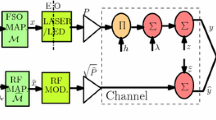Abstract
In this paper, we propose a new Adaptive Cooperation (AC) protocol for Free Space Optical (FSO) communications. Two versions of the protocol are presented. The first protocol uses the Instantaneous Signal to Noise Ratio (ISNR) to activate the relay only when the corresponding instantaneous throughput is better than that of the direct link. The second protocol uses the Average SNR (ASNR) to activate the relay when its average throughput is larger than that of the direct link. The proposed AC protocol has been extended to include Adaptive Modulation and Coding (AMC). Our results are valid for FSO communications in the presence of Gamma Gamma atmospheric turbulence.









Similar content being viewed by others
References
Abou-Rjeily, Chadi, & Kaddoum, Georges. (2019). Optical Spatial Modulation for FSO IM/DD Communications With photon-counting Receivers: Performance Analysis, Transmit Diversity Order and Aperture Selection. IEEE Journal on Selected Areas in Communications, 37(9), 2053–2068.
Abou-Rjeily, Chadi, Kaddoum, Georges, & Karagiannidis, George K. (2019). Ground-to-air FSO communications: when high data rate communication meets efficient energy harvesting with simple designs. Optics Express, 27, 34079–34092.
Abou-Rjeily, Chadi, & Noun, Zeina. (2016). Impact of Inter-Relay Co-Operation on the Performance of FSO Systems With Any Number of Relays. IEEE Transactions on Wireless Communications., 15(6), 3796–3809.
Al-Ebraheemy, Omer Mahmoud S, Salhab, Anas M, Chaaban, Anas, Zummo, Salam A, & Alouini, Mohamed-Slim. (2017). Precise outage analysis of mixed RF/unified-FSO DF relaying with HD and 2 IM-DD channel models. 2017 13th International Wireless Communications and Mobile Computing Conference (IWCMC), 1184–1189.
Alheadary, Wael G, Park, Ki-Hong, & Alouini, Mohamad-Slim. (2017). BER analysis of multi-hop heterodyne FSO systems with fixed gain relays over general Malaga turbulence channels. 13th International Wireless Communications and Mobile Computing Conference (IWCMC); 1172–1177.
Al-Qahtani, Fawaz S, Abd El-Malek, Ahmed H, Ansari, Imran S, Radaydeh, Redha M, & Zummo, Salam A. (2017). Outage Analysis of Mixed Underlay Cognitive RF MIMO and FSO Relaying With Interference Reduction. IEEE Photonics Journal 9(2).
Anguita, J. A., Djordjevic, I. B., Neifeld, M. A., & Vasic, B. V. (2005). Shannon capacities and error-correction codes for optical atmospheric turbulent channels. Journal of Optical Networking, 4, 586–601.
Balti, Elyes, Guizani, Mohsen, Hamdaoui, Bechir, & Maalej, Yassine. (2016). Partial Relay Selection for Hybrid RF/FSO Systems with Hardware Impairments. IEEE Global Communications Conference (GLOBECOM), 2016, 1–6.
Boluda-Ruiz, Ruben, Garcia-Zambrana, Antonio, Castillo-Vazquez, Beatriz, & Castillo-Vazquez, Carmen. (2016). Ergodic Capacity Analysis of Decode-and-Forward Relay-Assisted FSO Systems Over Alpha-Mu Fading Channels Considering Pointing Errors. IEEE Photonics Journal, 8(1).
Boluda-Ruiz, Ruben, Garcia-Zambrana, Antonio, Castillo-Vazquez, Beatriz, & Castillo-Vazquez, Carmen. (2016). MISO Relay-Assisted FSO Systems Over Gamma-Gamma Fading Channels With Pointing Errors. IEEE Photonics Technology Letters Year, 28(3), 229–232.
Dabiri, Mohammad Taghi, & Sajad Sadough, Seyed Mohammad. (2018). Performance analysis of all-optical amplify and forward relaying over log-normal FSO channels. IEEE/OSA Journal of Optical Communications and Networking Year, 10(2), 79–89.
Hasna, M. O., & Alouini, M. S. (2003). Outage probability of multihop transmission over Nakagami fading channels. IEEE Communications Letters, 7(5), 216–218.
Kong, Lei, Xu, Wei, Zhang, Hua, & Zhao, Chunming. (2016). Mixed RF/FSO two-way relaying system under generalized FSO channel with pointing error. Eighth International Conference on Ubiquitous and Future Networks (ICUFN), 264–269.
Sharma, Kumar, Prabhat, Bansal, Ankur, Garg, Parul, Tsiftsis, & Theodoros, & Barrios, Ricardo., (2017). Relayed FSO communication with aperture averaging receivers and misalignment errors. IET Communications, 11(1), 45–52.
Proakis, J. (2007). Digital communications (5th ed.). New York: Mac Graw-Hill.
Saleem, M, Ibraheem, M, Zafrullah, M, Awan, A. Outage analysis of RF/FSO using incremental and selective relay technique. 2016 International Conference On Computing, Electronic And Electrical Engineering (ICE Cube).
Trinh, Phuc V, Thang, Truong C, Pham, Anh T. (2016). Two-way all-optical AF relaying FSO systems over Malaga (M) channels with pointing errors. Ieee International Conference On Communications (ICC); 1 - 7.
Vu, Minh Q, Nguyen, Nga T T, Vu, Minh B, Phan, Hang TT, Pham, Hien TT, & Dang, Ngoc T. (2017). HAP-based FSO system using all-optical detect-amplify-and-forward relaying and coherent detection receiver. 4th NAFOSTED Conference On Information And Computer Science; 120 - 125.
Yang, Liang, Alouini, Mohamed-Slim, Shafique Ansari, Imran. (2018). Asymptotic performance analysis of two-way relaying FSO networks with nonzero boresight pointing errors over double-generalized gamma fading channels. IEEE Transactions On Vehicular Technology.
Zedini, Emna, Soury, Hamza, & Alouini, Mohamed-Slim. (2016). Outage probability of dual-hop FSO fixed gain relay transmission systems. 2016 IEEE 27th annual international symposium on Personal, Indoor, and Mobile Radio Communications (PIMRC); 1-6.
Author information
Authors and Affiliations
Corresponding author
Ethics declarations
Statement
On behalf of all authors, the corresponding author states that there is no conflict of interest.
Additional information
Publisher's Note
Springer Nature remains neutral with regard to jurisdictional claims in published maps and institutional affiliations.
Appendices
Appendix A : PDF of SNR of AF relaying when atmospheric turbulence follows a Gamma Gamma Distribution
The SNR of AF relaying between the source S, relay R and destination D is upper bounded by
If \(\Gamma _{SR}\) and \(\Gamma _{RD}\) are independent, the Cumulative Distribution Function (CDF) of \(\Gamma _{SRD}^{up}\) is given by
We deduce the PDF of \(\Gamma _{SRD}^{up}\) :
\(f_{\Gamma _{SR}}(x)\) and \(f_{\Gamma _{RD}}(x)\) are the PDF of SNR of first and second hop expressed similarly to (25), \(F_{\Gamma _{SR}}(x)\) is the CDF of SNR expressed as
where
\(F_{\Gamma _{RD}}(x)\) is the CDF of \(\Gamma _{RD}\) expressed similarly to (54) where we have to replace \({\overline{\Gamma }}_{SR}=E(\Gamma _{RD})\) by \({\overline{\Gamma }}_{RD}=E(\Gamma _{RD})\).
Appendix B
When there are K relays, we choose the relay node \(R_{sel}\) that has the best SNR:
Assuming that \(\Gamma _{SR_{k}D}\) are independent, the CDF of \(\Gamma _{SR_{sel}D}\) is given by
We deduce the PDF of \(\Gamma _{SR_{sel}D}\)
Rights and permissions
About this article
Cite this article
Halima, N.B., Boujemaa, H. Adaptive cooperation for free space optical communications. Telecommun Syst 75, 31–41 (2020). https://doi.org/10.1007/s11235-020-00672-y
Published:
Issue Date:
DOI: https://doi.org/10.1007/s11235-020-00672-y




